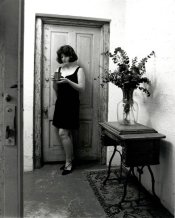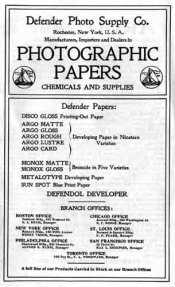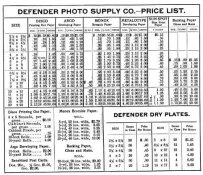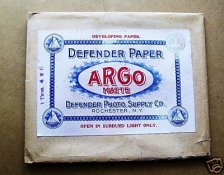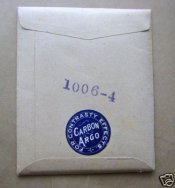Could you scan something that is neutral in tone, like a regular B&W print, or even part of an image that's been printed onto paper, like from a book or magazine? It kind of sounds like your scanner is all over the place...
-
Welcome to Photrio!Registration is fast and free. Join today to unlock search, see fewer ads, and access all forum features.Click here to sign up
You are using an out of date browser. It may not display this or other websites correctly.
You should upgrade or use an alternative browser.
You should upgrade or use an alternative browser.
Old Paper Again
-
A
- Thread starter Rlibersky
- Start date
Recent Classifieds
-
For Sale Nikon FE (blk) w/ 35-70 f/2.8 (Read)
- Started by Acere
-
Sold SOLD!
- Started by B.S.Kumar
-
For Sale FS: Linhof Master GTL / AMS 4x5 Camera
- Started by B.S.Kumar
-
For Sale Four H&Y Magnetic 4" Filter Holders and Four Cokin B&W Contrast Filters
- Started by Steve Goldstein
-
Sold Schneider Kreuznach Super-Angulon 165mm - 8x10
- Started by Guivd
Forum statistics
Here is a print from Berrger paper Grade 2 with Ilford Filters using a Arista cold light bulb. I'm not so sure it is the scanner as much as the monitor. Neither of the monitors I use are color calibrated for anything. The above prints look good on both of mine, at home and work one is a Scanview the other a Dell. The first batch of gray scale scans were made quite a bit smaller then needed for posting here and did cause some of the shift problems.
In the end the print as seen on the computer will probaly never accurately match the print in hand certainly not the texture of the paper. It is only a representation to show it has a good scale, considering the age, and is fog free using the formulas mentioned. More then that I can not do.
Randy
In the end the print as seen on the computer will probaly never accurately match the print in hand certainly not the texture of the paper. It is only a representation to show it has a good scale, considering the age, and is fog free using the formulas mentioned. More then that I can not do.
Randy
Attachments
So is no one interested in actually working with old paper. After all the comments about how much we missed the old stuff I thought this would generate more interest. As it is it turned into a discussion on my scanning abilities. Oh well.
If anybody is interested I would be interested in what you have done with old paper. Other then throwing it away of course.
If anybody is interested I would be interested in what you have done with old paper. Other then throwing it away of course.
Thomas Bertilsson
Member
I was hoping this thread would produce more answers and questions with respect to old papers too. Even though I have decided to leave the old stuff alone (there is nothing broken with my printing that needs to be fixed), it was interesting to see Randy's beautiful prints, and I was genuinely excited about the prospects.
The whole point of the thread was to show that it is indeed possible to print on old paper, and that the prints can be virtually fog free with a near miraculous print developer. And I can tell you that those prints were beautiful in the 'flesh'.
- Thomas
The whole point of the thread was to show that it is indeed possible to print on old paper, and that the prints can be virtually fog free with a near miraculous print developer. And I can tell you that those prints were beautiful in the 'flesh'.
- Thomas
Randy, I'm interested! The scans are just that .... scans. The defender 58D that you use has a chemical in it to control the fogging. What is it again and where can you get it? I have some old Opal, Velox, Azo and other papers that I would like to use. Does the defender 58D give you better results or do you like what you get with the LPD with the extra Benzo?
Jim
Jim
Randy,
I too am interested in the old papers. I have some old Azo (surface is E whatever that is), Haloid Industro, Convira and the original Zone VI Brilliant.
I just acquired some of the chemical Jim Fitzgerald mentioned, but being a practicing CPA keeps me out of the darkroom until post 4/15 :-(
I am looking forward to seeing what "develops" from these old papers.
Thanks for sharing your knowledge on methods for these old papers.
I too am interested in the old papers. I have some old Azo (surface is E whatever that is), Haloid Industro, Convira and the original Zone VI Brilliant.
I just acquired some of the chemical Jim Fitzgerald mentioned, but being a practicing CPA keeps me out of the darkroom until post 4/15 :-(
I am looking forward to seeing what "develops" from these old papers.
Thanks for sharing your knowledge on methods for these old papers.
Hi All,
I have very much enjoyed this thread. I am an emulsion historian trying to duplicate many of the old recipes with contemporary materials. I have samples of most of the old Kodak materials and a scattering of others and they are invaluable for research. Which brings me to a favor I would ask of anyone willing: Could you spare a small piece of any of the papers? A fully fixed and washed test piece with info on what developer was used would do just fine. PM me for my mailing address if you think you can help out. Thank you.
Denise Ross
http://www.thelightfarm.com/
I have very much enjoyed this thread. I am an emulsion historian trying to duplicate many of the old recipes with contemporary materials. I have samples of most of the old Kodak materials and a scattering of others and they are invaluable for research. Which brings me to a favor I would ask of anyone willing: Could you spare a small piece of any of the papers? A fully fixed and washed test piece with info on what developer was used would do just fine. PM me for my mailing address if you think you can help out. Thank you.
Denise Ross
http://www.thelightfarm.com/
Thomas Bertilsson
Member
Hi Jim,
I'm not the person you addressed the request to, obviously, but the component of the chemistry recipe that stands out as unique is the chlorohydroquinone.
Clay Harmon, the Turnip, found a source for it in Texas. I know Randy has a local source too, but don't know how reliable it is.
I have two liters of this developer mixed, and as soon as I can get the time, I'll try it on some of my expired paper.
- Thomas
I'm not the person you addressed the request to, obviously, but the component of the chemistry recipe that stands out as unique is the chlorohydroquinone.
Clay Harmon, the Turnip, found a source for it in Texas. I know Randy has a local source too, but don't know how reliable it is.
I have two liters of this developer mixed, and as soon as I can get the time, I'll try it on some of my expired paper.
- Thomas
Randy, I'm interested! The scans are just that .... scans. The defender 58D that you use has a chemical in it to control the fogging. What is it again and where can you get it? I have some old Opal, Velox, Azo and other papers that I would like to use. Does the defender 58D give you better results or do you like what you get with the LPD with the extra Benzo?
Jim
Randy, I'm interested! The scans are just that .... scans. The defender 58D that you use has a chemical in it to control the fogging. What is it again and where can you get it? I have some old Opal, Velox, Azo and other papers that I would like to use. Does the defender 58D give you better results or do you like what you get with the LPD with the extra Benzo?
Jim
Chlorohydroquinone CAS#615-67-8. I found I had to go to a local chemical company and have them order it for me. They got it from
Acros Organics
One Reagent Lane
Fairlawn NJ 07410
1-800-ACROS-01
At least this is the address on the MSDS.
I found the LPD formula gave a more neutral tone and the 58D gave a warmer tone. So it would depend on the look you want. The LPD with the Benzo did give a flatter print and didn't always keep the fog down. This has not been an issue with the 58D yet. Of the papers you mentioned they have done well in both.
I have not tried the amidol formula found in this article yet. But if I get the restrainer down to a minimum i believe I could get a better Neutral tone with this formula.
Old VC and RC (outdated before 1993 in my case) papers have not done well in any formula yet. Although I have not tried to much to find a formula that works. They have not been the type of papers I wish to use or print on.
If people are interest in exchanging prints printed on old paper I would be happy to trade. It would be nice to see what other printers are doings and compare theirs with mine.
Randy
Chlorohydroquinone CAS#615-67-8. I found I had to go to a local chemical company and have them order it for me. They got it from
Acros Organics
One Reagent Lane
Fairlawn NJ 07410
1-800-ACROS-01
At least this is the address on the MSDS.
I found the LPD formula gave a more neutral tone and the 58D gave a warmer tone. So it would depend on the look you want. The LPD with the Benzo did give a flatter print and didn't always keep the fog down. This has not been an issue with the 58D yet. Of the papers you mentioned they have done well in both.
I have not tried the amidol formula found in this article yet. But if I get the restrainer down to a minimum i believe I could get a better Neutral tone with this formula.
Old VC and RC (outdated before 1993 in my case) papers have not done well in any formula yet. Although I have not tried to much to find a formula that works. They have not been the type of papers I wish to use or print on.
If people are interest in exchanging prints printed on old paper I would be happy to trade. It would be nice to see what other printers are doings and compare theirs with mine.
Randy
That is the chemical. I remember checking the website for info on it and it was out of stock. This is something I want to experiment with. The shot of the woman with the guitar is excellent. I know it is a scan and all of that, but the look is fantastic.
I recently printed some negs on some old Azo. Maybe from the 60's in ansco 130 that I didn't modify and got some suitable ( to me) prints. I'll have to post a couple. The tones were very warm for Azo. Nice to know old paper can be used.
On another note if anyone wants to donate any old paper to me for my experiments with carbon transfer I will be willing to take it off of your hands for you.
Jim
I have not tried the amidol formula found in this article yet. But if I get the restrainer down to a minimum i believe I could get a better Neutral tone with this formula.
Randy
Randy,
I'm missing something....what article? What Amidol formula?
Thanks,
John
- Joined
- Aug 23, 2007
- Messages
- 44
- Format
- 35mm
Randy,
I too am interested in the old papers. I have some old Azo (surface is E whatever that is), Haloid Industro, Convira and the original Zone VI Brilliant.
I just acquired some of the chemical Jim Fitzgerald mentioned, but being a practicing CPA keeps me out of the darkroom until post 4/15 :-(
I am looking forward to seeing what "develops" from these old papers.
Thanks for sharing your knowledge on methods for these old papers.
Randy,
Starting in the mid-1940's, after rationalization of overlapping product names, Azo E was Fine-grain / Lustre / White. In the 1930's, E (in the Azo product line) was Fine-grain / Semi-matte / White. However, at that time E also represented other surfaces in other product lines.
Papermaker,
Thanks,
John
Thanks,
John
Randy,
I'm missing something....what article? What Amidol formula?
Thanks,
John
Must not have taken
http:////unblinkingeye.com/Articles/AntiqueP/antiquep.html
Randy,
This link doesn't work.

In Harvey W. Yurows article at http//:www.unblinkingeye.com Return to the Past - Collecting and Developing Antique Photographic Paper he says Developing agents giving normal to high contrast images and low fog are Amidol, Chlorohydroquinone (CHQ) and Glycin. I though that maybe this was due to the fact that they have a high reduction potential. But when I checked Edwal Laboratories has Amidol 35, CHQ 7, and glycin 1.6.
So the question is why are these developers considered to have a log fog potential?
I have found that CHQ works well as a low fog developer. It is warm and this is good for a number of subjects. Now I would like to find a colder toned developer as well. Amidol and Glycin can give colder tones but it will take a little experimenting to find if it can work for old paper.
From reading Modern Developing Methods from Edwal Laboratories it seems if I can keep alkalinity low it can help prevent fog.
So can it be assumed that the less alkaline accelerators such as Borax will be better then Sodium Carbonate for a low fog developer? Amidol does not need an accelerator to be active is this true of other developers?
Thanks
Randy
So the question is why are these developers considered to have a log fog potential?
I have found that CHQ works well as a low fog developer. It is warm and this is good for a number of subjects. Now I would like to find a colder toned developer as well. Amidol and Glycin can give colder tones but it will take a little experimenting to find if it can work for old paper.
From reading Modern Developing Methods from Edwal Laboratories it seems if I can keep alkalinity low it can help prevent fog.
So can it be assumed that the less alkaline accelerators such as Borax will be better then Sodium Carbonate for a low fog developer? Amidol does not need an accelerator to be active is this true of other developers?
Thanks
Randy
Randy;
It is not as easy as that. Carbonate and Borate both buffer best at around 9.5 - 10.5. An important characteristic is the ability of a developing agent to discriminate exposed vs unexposed grains. Mees and James lists pages of developers with their redox potentials and their capabilities to develop silver halide with proper imaging.
PE
It is not as easy as that. Carbonate and Borate both buffer best at around 9.5 - 10.5. An important characteristic is the ability of a developing agent to discriminate exposed vs unexposed grains. Mees and James lists pages of developers with their redox potentials and their capabilities to develop silver halide with proper imaging.
PE
How would a person go about finding the ability of developing agents to discriminate? It seems, by Yurow's article, that the mentioned agents have drastically different redox potential. Is it just the weaker solutions have a better ability to discriminate?
Paul Verizzo
Member
How would a person go about finding the ability of developing agents to discriminate? It seems, by Yurow's article, that the mentioned agents have drastically different redox potential. Is it just the weaker solutions have a better ability to discriminate?
Looking at Haist, most heavily on pp. 254-267 which deal with fogging and anti-foggants, there is nothing about differences in developers except for the quote below. Bottom line is that developers cannot differentiate between exposed silver and random silver. High pH and high solvent developers are more prone to fog.
The only developer related statement is "D.A. Viedenbach found that 'hydroquinone and pyrocatchol having two negative charges have a higher for forming effect on photographic materials than monoaminophenols, which carry only one negative charge while pyrogallol, which has three negative charges, fogs more than the first compounds.' "
Of course, that's pretty much a long winded way of saying highly active developers fog more. Doh.
PE, correct me if I'm wrong.
Paul;
You are correct as far as it goes.
You can add Stannous Chloride to the list and Hydrazine to the list. They fog emulsions totally because they are too strong, and you can alter the list by changing the pH where you compare the HQ and PG in the above quote. The pH change alters the ionization.
Then consider the phenidone family which is not ionized and you can compare 3 different redox potentials in the same family with essentially no ionization. Again, one can compare p-phenylene diamine developers which form positive salts and are therefore unionized in base.
So, you see this is not simple. I again refer you to Mees and James for a more thorough review. They list pages of developers, redox potentials and image vs fog formation figures.
PE
You are correct as far as it goes.
You can add Stannous Chloride to the list and Hydrazine to the list. They fog emulsions totally because they are too strong, and you can alter the list by changing the pH where you compare the HQ and PG in the above quote. The pH change alters the ionization.
Then consider the phenidone family which is not ionized and you can compare 3 different redox potentials in the same family with essentially no ionization. Again, one can compare p-phenylene diamine developers which form positive salts and are therefore unionized in base.
So, you see this is not simple. I again refer you to Mees and James for a more thorough review. They list pages of developers, redox potentials and image vs fog formation figures.
PE
Recently I came across these:

and this

I'm sure I have a few projects that would suit them but at the moment no time.
I have some Agfa Nuetol dev and if that's not OK can get Fomatol PW a warm-tone dev based on glycin.
Not sure of the age of the papers above, but I'll take a guess pre-war.
Mark

and this

I'm sure I have a few projects that would suit them but at the moment no time.
I have some Agfa Nuetol dev and if that's not OK can get Fomatol PW a warm-tone dev based on glycin.
Not sure of the age of the papers above, but I'll take a guess pre-war.
Mark
Does anyone know what era this paper is from? Defender Argo. It is interesting they put the managers of the various stores on the instructions.
I bought this paper off eBay. The envelope was in perfect shape. Looking forward to seeing what it looks like.
I bought this paper off eBay. The envelope was in perfect shape. Looking forward to seeing what it looks like.
Attachments
Thats early. What did the outer envelope look like?
| Photrio.com contains affiliate links to products. We may receive a commission for purchases made through these links. To read our full affiliate disclosure statement please click Here. |
PHOTRIO PARTNERS EQUALLY FUNDING OUR COMMUNITY:  |


